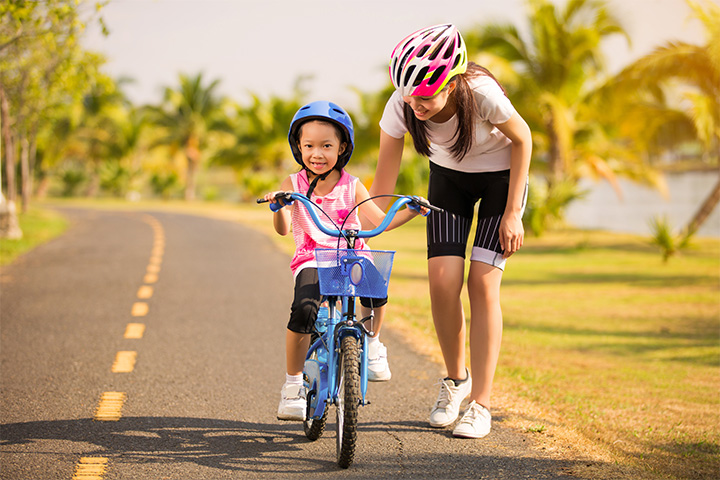image: Shutterstock
Riding a bike is a milestone for children. Besides being a great form of exercise, it gives them a sense of confidence and independence. It is also a fun activity for them. Children could also be influenced by their friends who ride bikes and could wish to ride one themselves.
Teaching your child to ride a bike might seem difficult as you need to spend time on it, have patience, and ensure your child does not get serious injuries. However, the task can become more manageable, and you both can spend some quality time together if you follow a few tips.
In this post, we discuss the various aspects of teaching a child to ride a bike – when you can start, what you will need, and what you can expect. We also tell you how to teach a kid to ride a bike.
When Can A Child Learn To Ride A Bike?
While some children learn to ride a bike at their own pace, the average age for learning how to ride a bike is between four and eight. Most children start riding a bike with training wheels when they are around two years of age (1).
Children can start riding two-wheeled bikes without training wheels around the ages of four to eight as they have the physical coordination and agility required for riding a bicycle.
Generally, children who learn to ride a bike when they are around six to eight years old are less prone to injuries than those who learn to ride between three to five years of age.
Bikes for children are of different types and sizes depending on children’s ages and skill levels.
1. Tricycles
These are the first bikes a child rides. They consist of three wheels set in a triangular form and may or may not come with pedals. They do not need balancing, and children as young as one year can ride them.
2. Balance bike
These are lightweight bikes without pedals and brakes. They are ideal for children just learning to ride on two wheels as they allow them to concentrate on balancing and steering rather than pedaling. Children aged two to five years can ride balance bikes.
3. Bike with training wheels
These are regular bikes that come with two smaller wheels attached to both sides of the hind wheel. These wheels serve the purpose of providing support to the rider. They make the children concentrate more on pedaling than steering and balancing. Children aged four to eight can ride these bikes.
4. Bike without training wheels
These bikes are the regular bikes you see on the roads. They come with brakes and pedals. A child who can balance well can transition to a bike without training wheels easily. If your child has experience riding a balance bike, they can ride a bike without training wheels as early as four years of age. The usual age when children opt out of using training wheels is around six to eight years.
Things To Do Before Teaching Your Child To Ride A Bike
So, you have made up your mind to teach your child how to ride a bike, and they are raring to go. But before you start, here are some important things you should keep in mind.
1. Finding the right bike
There are innumerable models of bikes on the market. One of the first things you will notice about children’s bikes is that they are not built of the same quality as adult’s bikes, primarily because most parents are not willing to spend extra bucks on something a child will outgrow in a couple of years.
Look for a bike that is age-appropriate for your child. If possible, let your child sit on it and see if they can comfortably put their legs on the ground. They should be able to touch the ground with the sole of their foot. You could also go for adjustable bikes so that your child can use them for a longer time.
2. Taking the appropriate safety measures
Ensure your child always wears a safety helmet no matter where they are riding the bike or who they are with. By making them wear a helmet, you can protect them from severe injuries.
The helmet should fit snugly on your child’s head – ideally around one inch from their eyebrows. If it is too low or high or too loose, consider buying another one that fits well. You could also consider buying other safety gear, such as gloves, elbow and knee caps, and shin guards.
3. Inflating the bike tires to the right pressure
Make sure you inflate the tires of the bike to the correct pressure. This will ensure your child has a smooth riding experience. The correct amount of pressure required is usually mentioned on the side of the tire.
Remember that over-inflating a tire can be as hazardous as a punctured or under-inflated tire. Tires with inappropriate tire pressure can make the bike unsafe and cause nasty falls.
4. Choosing a good location
The place where you decide to teach your child to ride must be safe and easy to maneuver. It should preferably be a tarmac road with little to no traffic, including pedestrians. A road with a slight slope will make learning the bike easier for the child.
It is essential to select a good road the first time your child rides a bike because this can make or break the child’s confidence. If the road is too slushy or rocky or if there is too much traffic, your child might lose their confidence even before mounting the bike.
15+ Tips To Teach A Kid To Ride A Bike
In the earlier days, children learned to ride a bike using training wheels. The main problem with this method was that it taught children pedaling first rather than balancing. And when the balancing wheels are removed, children have to learn to balance again.
The following tips will ensure that whichever bike you select, your child will be riding it like a pro in no time, and you won’t have to undergo the stress of training.
1. Check if your child wants to learn it
Some parents pressure their children to learn how to ride bikes. If your child is not eager to learn it yet, talk to them about their reasons instead of pressuring them. When your children are pushed into the activity, they might not be as open to learning as they would have if they had opted to do it themselves. Even if they learn it, they won’t enjoy it as much. The training can also become an uphill task. To avoid this, talk with your child and ask them if they want to learn to ride a bike.
2. Teach balancing first
The first step to learning to ride a bike is balancing. Once a child learns to balance, pedaling, steering, and braking are easy to learn. You can teach them to balance in other activities as well. Use balance boards, gymnastics, skateboards, or skates to teach them to balance their bodies in all situations. When children learn to ride a bike, they will instinctively balance themselves due to these other techniques.
3. Remove the pedals
If you do not have a balance bike, you can create one by simply removing the pedals of a regular bike. This is an essential step for your child to learn. They can keep their feet on the ground and walk the bike. Encourage them to increase their speed slowly. At one point, they will be confident enough to pull up their legs and ride along.
With practice, they can increase the time they keep their feet off the ground. Once they feel comfortable riding for 15 seconds or more in one go, you can reattach the pedals or transition to a pedaled bike.
4. Teach them how brakes work
Once your children are on pedaled bikes, they will need to know how to stop the bike. Teach your child about how brakes work and where they are. They also need to know how and when to use them so that they do not pull the brakes at every opportunity. Also, ask them to place their feet down when they pull the brakes to minimize falls.
5. Set realistic expectations
Many parents make the mistake of imposing their own rules and expectations on their children. If they have learned to ride a bike within 15 minutes, they want their children to learn it in 15 minutes as well. This sort of pressure might dent your child’s confidence, and they might take even longer than they usually do to learn something new. This might also lead to unnecessary frustration. Instead, let them learn the new skill at their own pace.
6. Be positive
Children are perceptive, and they can sense if you are anxious. They will become anxious too if you do, and the whole learning session can be affected adversely. Instead, maintain a positive attitude during the training sessions. Do not say things such as, “Why can’t you just look up?” Instead, say positive things such as “You are doing good!” or “Well done!” This will boost their confidence, and they will be more eager to try.
7. Keep the instructions simple
When your child is learning to ride a bike for the first time, they already have a whole lot of things to concentrate on. If your instructions are complicated, they might get confused. Keep your instructions simple, especially when they are riding the bike. Before they start riding, talk to them calmly and explain what they are supposed to do. While they are riding, give them simple instructions such as “Pedal!” or “Stop!” instead of “Why did you stop pedaling? “Move your legs faster!” and so on.
8. Practice for a set time
It is a good move to use a timer so that your children can see how much time of training is left. If they take long breaks for tying their shoelaces or drinking water, pause the timer and restart it when they are ready again. A practice session spanning 30 minutes each day is ideal.
9. Prepare for success
When you decide to teach your child to ride a bike, you need to make sure all the parties involved are well-rested and well-fed. Tired or hungry children are not the ideal subjects for learning a new skill. You should also keep all the things you might need for the training session ready. Well-fitting shoes, safety gear, a bike with proper tire pressure and seat height, and a water bottle are things you will need to factor in for a good training session.
10. Don’t hold on to the bike
Hold the bike when your child first mounts it. Let them start pedaling it, and once they push off, leave the bike. Do not hold the bike or run alongside them. You might want to stand at the end of the trail or road you have chosen so that your child has some encouragement to ride the bike towards you. If you hold the bike, your child will take more time to balance on their own. Instead, say encouraging words to them from the other end and watch them come towards you.
11. Teach them how to turn
Once your child has mastered how to balance on a straight road, encourage them to undertake turns. If the road you have chosen has some gentle turns, you can use them, and if not, you can place some obstacles for them to maneuver around while riding. Keep it easy and place bigger obstacles farther away initially. As time goes, you can place smaller obstacles nearer to challenge and hone your child’s riding skills.
12. Look at the destination
The most common mistake children, or even adults, make while learning to ride a bike in the initial days is to look ahead of the front wheel. They invariably focus on ditches and bumps on the road and ride into them. This makes them lose confidence. You can instruct your child to look straight at the destination. The rider goes where their eyes tell them to go – this is a universal rule for bike riding, and your child needs to remember this.
13. Be patient
A child might take any time between a couple of days to four weeks to learn to ride a bike. If you build a lot of pressure on your child, they might take more time to learn it. If the training becomes too stressful for either of you, it might be a good idea to take a break. Often, children also tend to lose interest as the initial excitement wanes. Try to keep a positive attitude, and try again after some days.
14. Incentivize
While some children might take falling and getting hurt in their stride, others might feel overwhelmed by it all. However, falling while learning to ride a bike is inevitable. You can make it seem worthwhile to your children by offering small incentives. This will keep them coming back to the practice willingly. Do not promise anything huge; an ice cream run would do.
15. Do not worry if your child falls
Many parents do not like it if their child falls, and they become increasingly anxious. If the child cries, they have a strong urge to leave everything, pick up the child, and go home. While you have to be with your child when they are learning to ride, you must not allow yourself to become anxious and give up. Comfort them and continue with the training.
16. Remember to have fun
In the end, you have to remember that you are going through all this so that your child can have fun. If you make the training stressful, they will start associating it with negative feelings. Instead, you can have fun along with your child and use this as an opportunity to bond with them.
Teaching a kid to ride a bike can be a bumpy experience for you and your children. However, with these tips, you can ace the training. Your children will be riding a bike in no time with confidence, and you will experience a world of happiness.


































